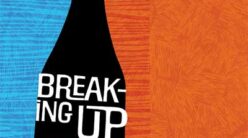Three years ago, Oliver Glanz climbed the Watzmann Traverse, a rugged climb across the Watzmann massif in the Bavarian Alps. The traverse crosses the three main peaks, including the Mittelspitze, which is the third-highest peak in Germany. Usually, the “Watzmann Tour” is done in two days, but Glanz, a professor at Andrews University in Michigan, challenged himself to complete it in eight hours. He ran as much of the trail as he could, sometimes even jumping between rocks. “It was just pain,” he says of the experience, “but I came back so refreshed.”
What is Type 2 Fun?
Glanz’s alpine climb might be categorized as “type 2” fun, what Kelly Cordes in an REI blog post defines as “miserable while it’s happening, but fun in retrospect.”
Here’s how the types of “fun” activities break down:

For Glanz, “fun” (definitely type 2) is all about adventure, resonance, and the self-emptying that happens when he sees “death yawning” at him on a mountain edge.
“People have a lack of resonance. They are not in touch with reality anymore, with their mortality, with their joys, their skills, their body,” says Glanz, who goes to the mountains to find this resonance and “to get a sense of what is around me.”
Confronting Character
Patrick Slevin, a public affairs consultant, former Florida mayor, university lecturer, and author, finds his “resonance” in ultramarathons, like the infamous Death Race.
“When life is comfortable, we fall into mental, physical, and spiritual atrophy,” Slevin says. Ultramarathons “offer some real dangers and suffering under controlled environments.” Like Glanz, Slevin appreciates the self-emptying that occurs under extreme conditions. “When you purge ego and worldly concerns, you’re then faced with your raw character. . . . Suffering purges the worldly priorities and acts like a tuning fork to recalibrate and refocus on what’s important.” For Slevin, the important things in life are “God, country, and family.”
Exercising Determination
Not all type 2 fun has to take place outside, crawling through mud or clinging to a rock face. Nor does it have to be a one-off race. Challenging yourself physically, mentally, and emotionally is healthy and can be part of your daily lifestyle. Julenne Gil, a physical therapist and survivor of childhood cancer, challenges herself through exercise.
“Most of us know that exercise is good for us. It builds muscle, increases our cardio ability, improves our immune system, and releases endorphins, which help us feel happy,” says Gil. “But, for me, pushing myself physically to limits I never thought I was capable of builds a mental toughness unlike any other. It teaches you life isn’t always going to be easy but you have to come at it with all you’ve got.
“Pushing myself to physical extremes reminds me that, while cancer may have told me I never could, with the drive, willpower, and determination God has instilled into me—and us all—I am able to hit goals I was told by people I wouldn’t be alive to reach.”
Seeking Family Adventure
Type 2 fun comes naturally to Jessie and Johnathon Jorgensen. They spent their dating years on a university gymnastics team and going rock climbing and hiking in the mountains of eastern Tennessee. As a married couple, they consistently challenge themselves and each other—they recently took a whirlwind 36-hour tour of Zion National Park that included the strenuous Angels Landing hike.
Now that they are parents of two young boys, they have incorporated adventure into their parenting style. They are committed to getting outside every day even when the weather is cold, and are intentional about doing things they enjoy with their kids. When their six-year-old son is riding his dirt bike, “I’m on a bike right next to him,” says Johnathon, a commercial loan officer. “And when we go to the beach, we’re both in the water swimming.”
“I think it’s important for kids to watch their parents do hard things,” remarks Jessie, a stay-at-home mom. She recently ran a half-marathon and enlisted her oldest son to help her train. While she ran, he rode next to her on a bike and reminded her to drink the electrolytes he carried for her. “He was ‘Electro-Boy,’” says Jessie. “To have him see and be part of us training for hard things is good because when he has hard things coming up, he will know that ‘we work hard for this, we can do hard things.’ What kind of parent would I be if I asked him to do a hard thing but I chose the easy road?”
“Everybody has different categories of hard things,” Jessie says. “Sure, training for a half-marathon is hard, but so is being a full-time, working parent. Everyone has something hard they are doing in their life. You already are doing something hard. If you want to go out and do this ‘adventure’ hard thing, you just need to shift your mindset: ‘I already do hard things. This is another hard thing. Let’s commit to doing this.’ Start off small and build your confidence.”
Getting kids to do hard things can be difficult, so Johnathon recommends gamifying everything: Their oldest son wanted to help Jessie train because he got to be “Electro-Boy.” They also incorporate games into other activities with their children. “When we are on hikes, we create games, so we play I Spy or some kind of game while we are on the trail. It immediately changes their mindset.” (It also makes the activity more fun for the adults!)
It is common for children to respond to commands beginning with “don’t” by doing the opposite because they do not register the negative command. Instead of using negative phrasing like “don’t let go,” Johnathan and Jessie intentionally use positive, encouraging phrases like “hang on strong.” This positivity results in a shift in mindset that creates a can-do attitude—something the Jorgensens have been cultivating in their lives even before kids.
Just Do It
Discomfort leads to growth. On the flip side, fear of failure and discomfort inhibits personal growth. Being overcautious can lead to habitual rejection of new activities, skills, and ideas in favor of what is comfortable, known, and safe. Those who engage in type 2 fun recognize the discomfort of an activity but do it anyway because the reward is greater and lasts longer than the temporary inconvenience or pain. It can be difficult to change your mindset from “I can’t” to “I can,” but persistent effort will build mental and physical resilience. Start small, commit to it, and do it. You won’t regret it—and even if you do, that’s type 3 fun!






